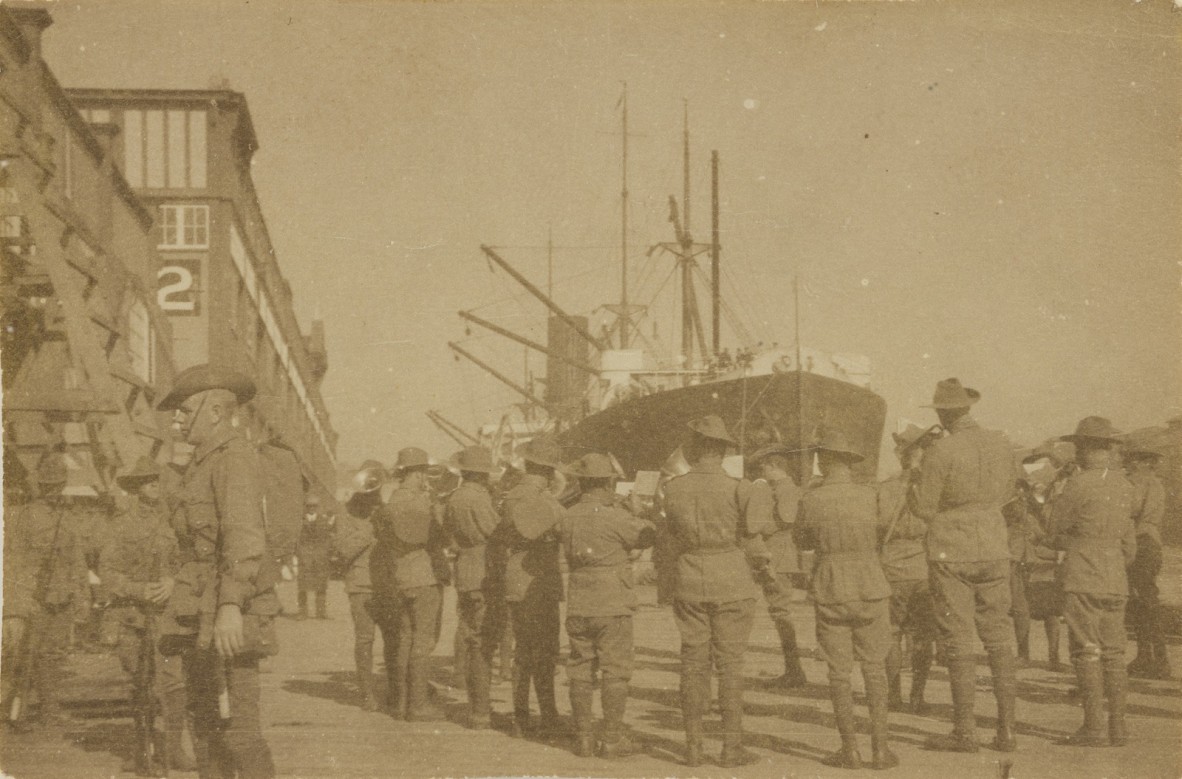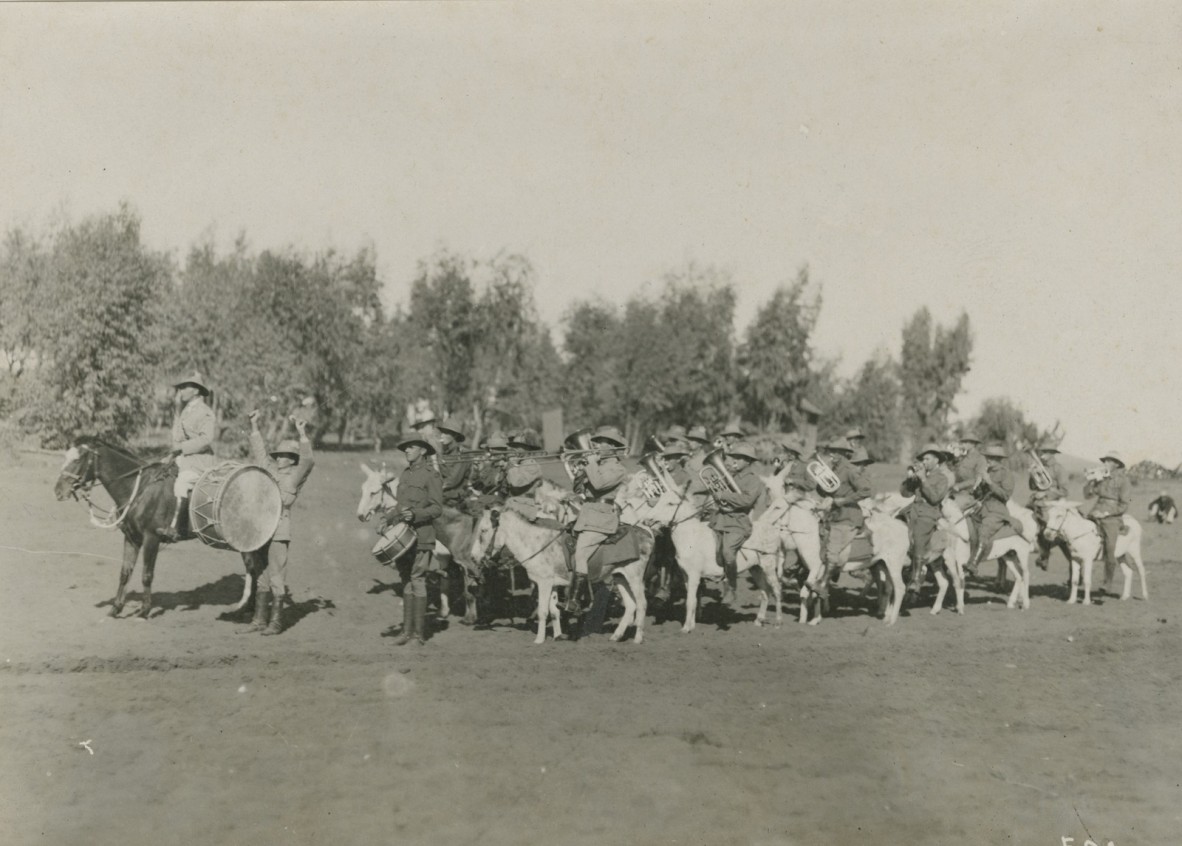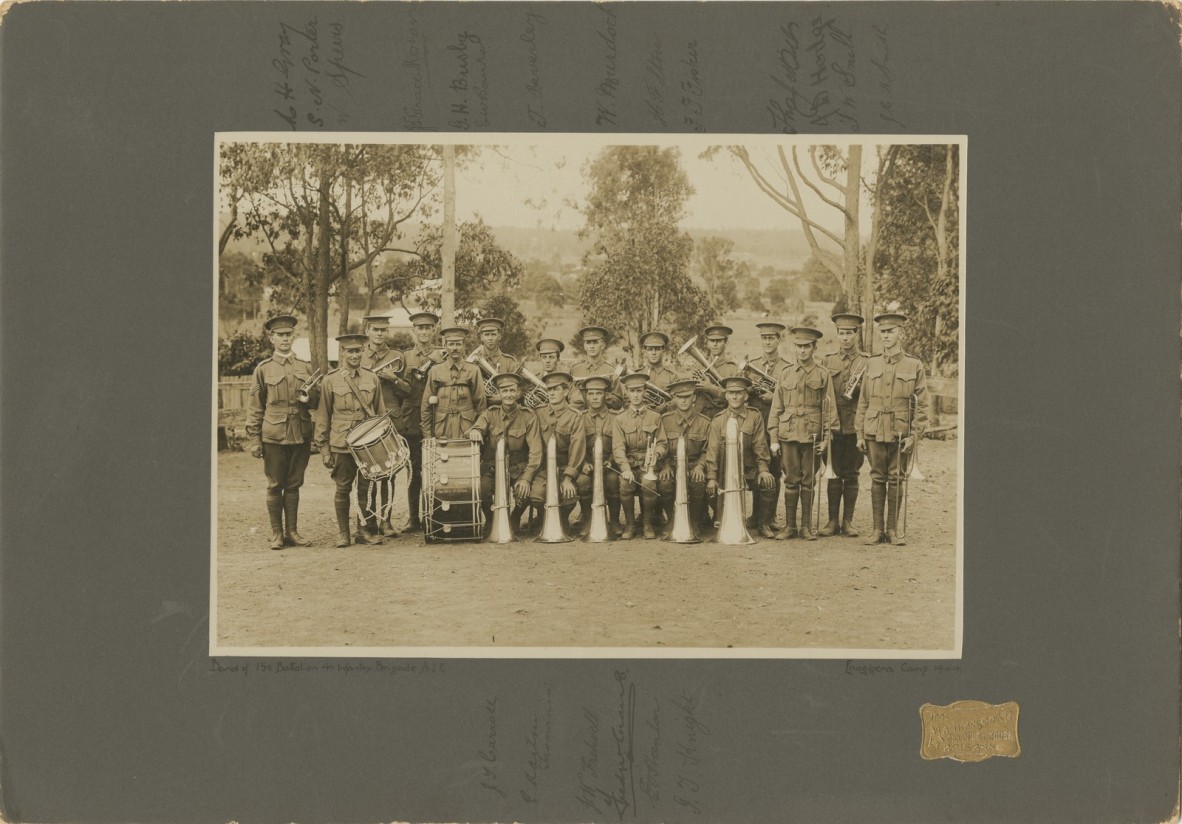And the Band Played On: Battalion Bands World War One
By Alice Rawkins, Visitor Service Assistant, Anzac Square Memorial Galleries | 9 April 2021
Music can lift moods, combat depression, reduce stress and even ease pain. Beyond entertainment, it has the uncanny ability to elicit powerful emotions among listeners, draw people together and provide an escape from reality. Unsurprisingly, Battalion bands played a significant role during the First World War, raising morale among troops and contributing some much-needed light relief.

Courtesy State Library of Queensland, Band members of the 25th Infantry Battalion on the wharf, Sydney, New South Wales, 1915, Image no. M946-0079-0029
Battalion bands were formed early in WWI to perform musical duties at military functions and consisted mainly of wind and percussion instruments. Music was used as means of communication, signalling troops to mobilise, advance or retreat. The distinctive calls of the bugle were used to regulate daily military life. This instrument or a trumpet was used to wake troops up, call them to eat, tell them when to start and stop their duties, call them to assembly, and, on Sunday, to church. Battalion bands were also responsible for entertaining troops at rest, accompanying funerals, playing at sport meetings and medal presentations, and providing impetus to troops on extended marches. The sounds of battalion bands became part of daily life for most troops.
Battalion bands became highly respected for their commitment to bring music to troops, their ability to rally soldiers and their ingenuity in the face of challenging circumstances. The Anzac Mounted Division, stationed in the Middle East, was given the task of training white Sudanese Donkeys to walk in formation while they played. It was difficult to train donkeys to walk in formation, so the four leading donkeys were tied together by their head ropes, allowing the drummers at the front of the band to direct the donkeys behind them. The 9th Battalion band was praised for their thoughtfulness in playing ‘Veni, Vidi, Vici’ (this Latin phrase, supposedly uttered by Juilus Ceasar, means ‘I came, I saw, I conquered’) as the battalion marched through the French village of Dernancourt. Bands maintained morale among troops and provided, if somewhat brief, a distraction from the death and destruction that haunted soldiers.

Courtesy State Library of Queensland, Military band in formation on donkeys in the Middle East, 1914-1919, Image number: OM78-70-0002-0021
Battalion bands faced many challenges during WWI, including high casualty rates. While military regulations stipulated that 25 bandsmen could remain behind lines, they were expected to move transport lines and aid as carriers during emergencies. It was also common for bandsmen to serve as stretcher bearers, a highly vulnerable position. Casualty rates among stretcher bearers were high, as they often performed their duties while under direct fire. Like other soldiers, bandsmen could fall ill, be injured, or killed in action. This became apparent following the ill-fated Gallipoli Campaign. The 15th Battalion’s band was particularly hard hit, with only eight of its original 31 members surviving Gallipoli. High casualty rates among numerous battalion bands saw military officials suggest that bands be formed at a bridge level. Some attempts were made to re-form battalion bands in Egypt, but these had limited success. Most battalion bands, despite dwindling numbers, continued to play on. By 1916 the importance of battalion bands for the emotional health of troops was recognised by the Australian Military Headquarters, who called for every battalion or brigade to have a band of some sort.

Courtesy State Library of Queensland, Military band of the 15th Battalion, 4th Infantry Brigade at Enoggera Camp, Queensland, 1914, Image no. 6163-0001-0001
Despite a wide range of responsibilities, battalion bands were not officially recognised by the Australian Imperial Forces during WWI. Due to this unofficial status, sheet music and instruments were not provided by the military but instead were often donated by members of the community or purchased with the assistance of organisations like the Red Cross or Australian Comforts Fund. Several public fundraisers were also held to equip battalion bands. In 1916 a fundraising concert was hosted in Ipswich’s town centre to raise money to buy instruments for several local boys who had enlisted and been placed in battalion bands. The Queensland Times newspaper promoted the event arguing that the heavy burdens of troops were “lightened by the cheery sounds of the regimental band” (Sat 29 Jan 1916, p. 10). It was also common for soldiers to bring their own sheet music and instruments from home.
This Anzac Day when you hear the familiar tones of the bugle at commemorative events take a moment to remember the battalion bands who worked tirelessly to bring music and joy to those serving overseas during the First World War. You can learn more about music during WWI by visiting the Anzac Square Memorial Galleries, open 10am-4pm Sunday to Friday.
Additional Resources:
- https://www.anzacsquare.qld.gov.au/
- https://www.slq.qld.gov.au/blog/digitisedslq-joseph-cecil-thompson-collection
- https://www.slq.qld.gov.au/blog/oh-listen-band-rudyard-kipling-speech
Comments
Your email address will not be published.
We welcome relevant, respectful comments.